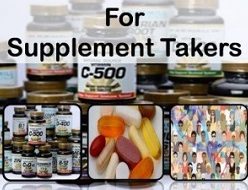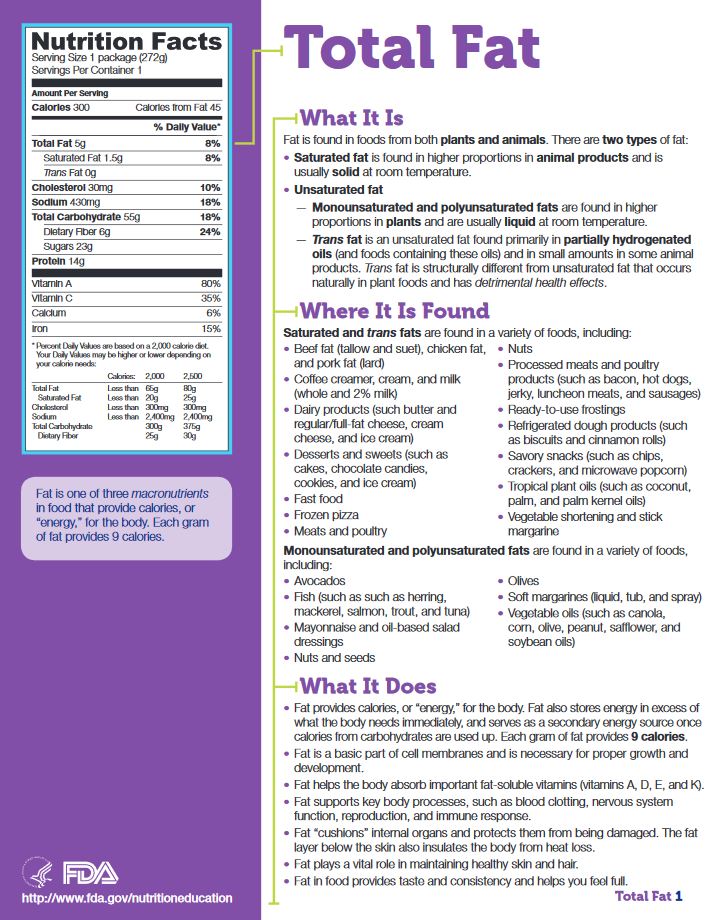
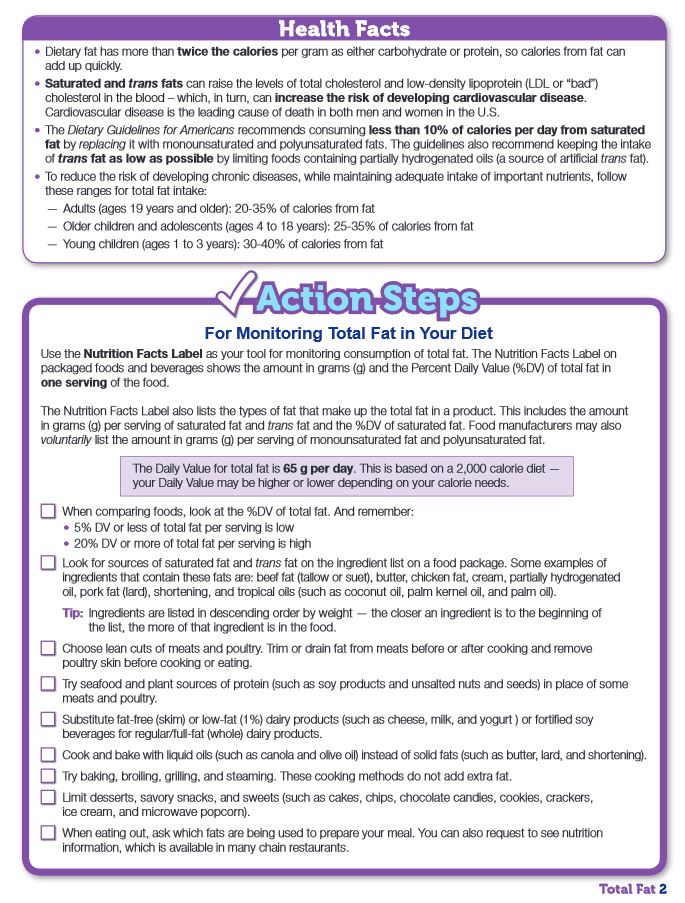
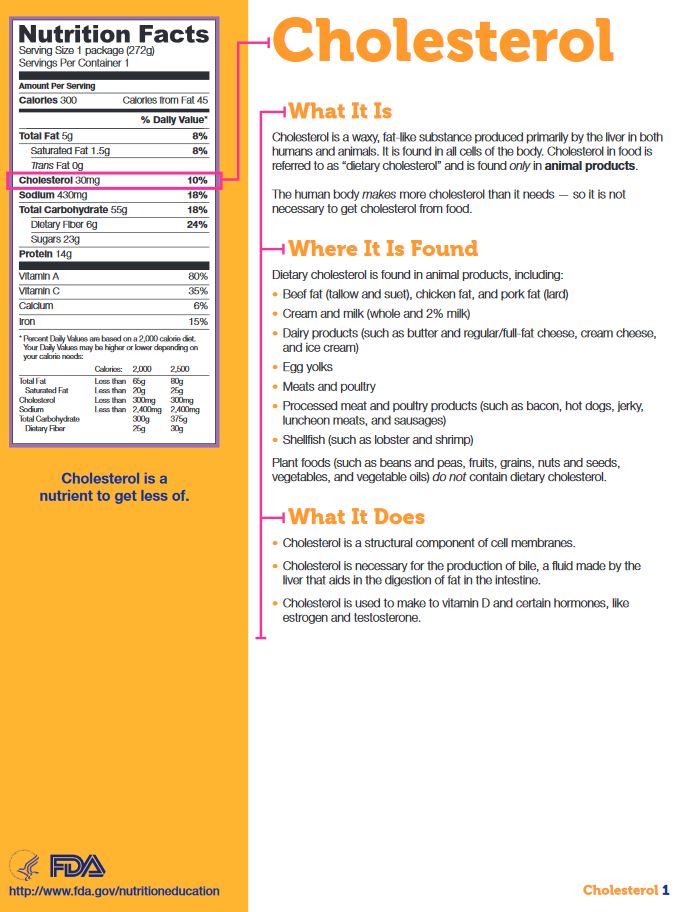
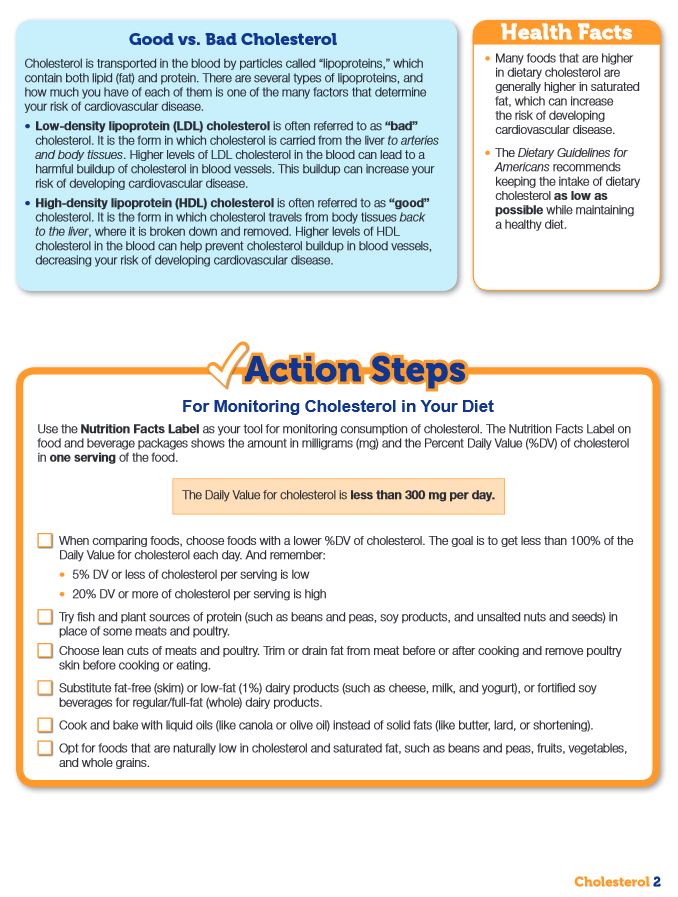
FEATURE TOPICS FROM USDA/HHS
The skinny on fats
Fats and oils are part of a healthy diet and play many important roles in the body. Fat provides energy and is a carrier of important nutrients such as vitamins A, D, E, and K and carotenoids. But fat can impact the health of our hearts and arteries in a positive or negative way, depending on the types of fat we eat. Experts recommend getting between 20 and 35 percent of calories from total fat, with most fats coming from sources of “good” fat, such as fish, nuts, and vegetable oils.
Note: The term Fats when used on Nutrition Facts and Supplement Facts panel labeling includes both fats and oils.
Source: HHS
How are oils different from solid fats?
All fats and oils are a mixture of saturated fatty acids and unsaturated fatty acids. Unsaturated fatty acids include monounsaturated and polyunsaturated fats.
Oils are fats that are liquid at room temperature, like the vegetable oils used in cooking. Oils come from many different plants and from fish. Oils contain more monounsaturated and polyunsaturated fats.
Solid fats are fats that are solid at room temperature, like beef fat, butter, and shortening. Solid fats mainly come from animal foods and can also be made from vegetable oils through a process called hydrogenation. Solid fats contain more saturated fats and/or trans fats than oils. Saturated fats and trans fats tend to raise “bad” (LDL) cholesterol levels in the blood, which in turn increases the risk for heart disease. To lower risk for heart disease, cut back on foods containing saturated fats and trans fats.
What are “oils”?
How much is my allowance for oils?
- nuts
- fish
- cooking oil
- salad dressings
Others could easily consume the recommended allowance by substituting oils for some solid fats they eat. A person’s allowance for oils depends on age, sex, and level of physical activity. Daily allowances for oils are shown in the table below.
Note: Click on the top row to expand the table. If you are on a mobile device, you may need to turn your phone 90 degrees to see the full table.
| Daily Allowance | |||
|---|---|---|---|
|
Children
|
2-3 years old
4-8 years old |
3 teaspoons
4 teaspoons |
|
|
Girls
|
9-13 years old
14-18 years old |
5 teaspoons
5 teaspoons |
|
|
Boys
|
9-13 years old
14-18 years old |
5 teaspoons
6 teaspoons |
|
|
Women
|
19-30 years old
31-50 years old 51+ years old |
6 teaspoons
5 teaspoons 5 teaspoons |
|
|
Men
|
19-30 years old
31-50 years old 51+ years old |
7 teaspoons
6 teaspoons 6 teaspoons |
|
How do I count the oils I eat?
The table below gives a quick guide to the amount of oils in some common foods.
Note: Click on the top row to expand the table. If you are on a mobile device, you may need to turn your phone 90 degrees to see the full table.
| Oil table | |||||
|---|---|---|---|---|---|
| Amount of food | Amount of oil | Calories from oil | Total calories | ||
| Teaspoons/grams | Approximate calories | Approximate calories | |||
| Oils: | |||||
| Vegetable oils (such as canola, corn, cottonseed, olive, peanut, safflower, soybean, and sunflower) |
1 Tbsp | 3 tsp/14 g | 120 | 120 | |
| Foods rich in oils: | |||||
| Margarine, soft (trans fat free) | 1 Tbsp | 2 ½ tsp/11 g | 100 | 100 | |
| Mayonnaise | 1 Tbsp | 2 ½ tsp/11 g | 100 | 100 | |
| Mayonnaise-type salad dressing | 1 Tbsp | 1 tsp/5 g | 45 | 55 | |
| Italian dressing | 2 Tbsp | 2 tsp/8 g | 75 | 85 | |
| Thousand Island dressing | 2 Tbsp | 2 ½ tsp/11 g | 100 | 120 | |
| Olives*, ripe, canned | 4 large | ½ tsp/ 2 g | 15 | 20 | |
| Avocado* | ½ med | 3 tsp/15 g | 130 | 160 | |
| Peanut butter* | 2 T | 4 tsp/16 g | 140 | 190 | |
| Peanuts, dry roasted* | 1 oz | 3 tsp/14 g | 120 | 165 | |
| Mixed nuts, dry roasted* | 1 oz | 3 tsp/15 g | 130 | 170 | |
| Cashews, dry roasted* | 1 oz | 3 tsp/13 g | 115 | 165 | |
| Almonds, dry roasted* | 1 oz | 3 tsp/15 g | 130 | 170 | |
| Hazelnuts* | 1 oz | 4 tsp/ 18 g | 160 | 185 | |
| Sunflower seeds* | 1 oz | 3 tsp/ 14 g | 120 | 165 | |
